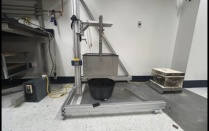Constraining Heat Transfer and Melt Water Production Processes of Lava-Ice Interactions
By James perry, Cal Poly Humboldt
Advisors: Catheryn Ryan , Earth Science, University at Buffalo
Project Objectives
•Replicate surface and subglacial lava-ice interactions using small scale laboratory experiments.
•Measure heat transfer and meltwater production resulting from lava-ice interactions. Tests will also include adding varying basalt sediment grains to determine possible insulating effects.
•Analyze final lava texture to better understand geologic features associated with glaciovolcanic events.
Data and Results
•Basalt samples are either heated to 600℃ for preliminary “hot rock” tests or heated to 1200℃ until fully melted. The samples are carefully placed or poured onto the ice block or placed on a steel plate which is inserted at at the bottom of the basket and the ice block placed on top
•Experiments will be conducted with both pure-ice and sediment bearing ice
•Temperature probes are applied to varying locations, commonly including: The meltwater collection bucket, the rock exterior, and the rock interior via drill hole
•Rock/lava temperatures and weight of melt water are recorded over time
Significance
•Glaciovolcanism has major implications for both human populations as well as landforms/land formation, but are impossible to study in their initial stages as they occur under ice cover. Studying these types of events in controlled lab settings can help us better understand the hazards (such as flooding from meltwater production) and subsequent landforms associated with lava-ice interactions.
Publication or Conference
None at this time
------------------------------------------------------------------------------------------------
Center for Geological and Climate Hazards
Interdisciplinary Research Experience for Undergraduates in Atmospheric and Geological Hazards

Experiment setup. A wire mesh basket is suspended above a catchment bucket resting on a scale. A furnace (seen Right) is connected to a control box (seen left) which sets the desired temperature of the furnace. Thermal probes are connected to a monitor and are later placed in various locations.